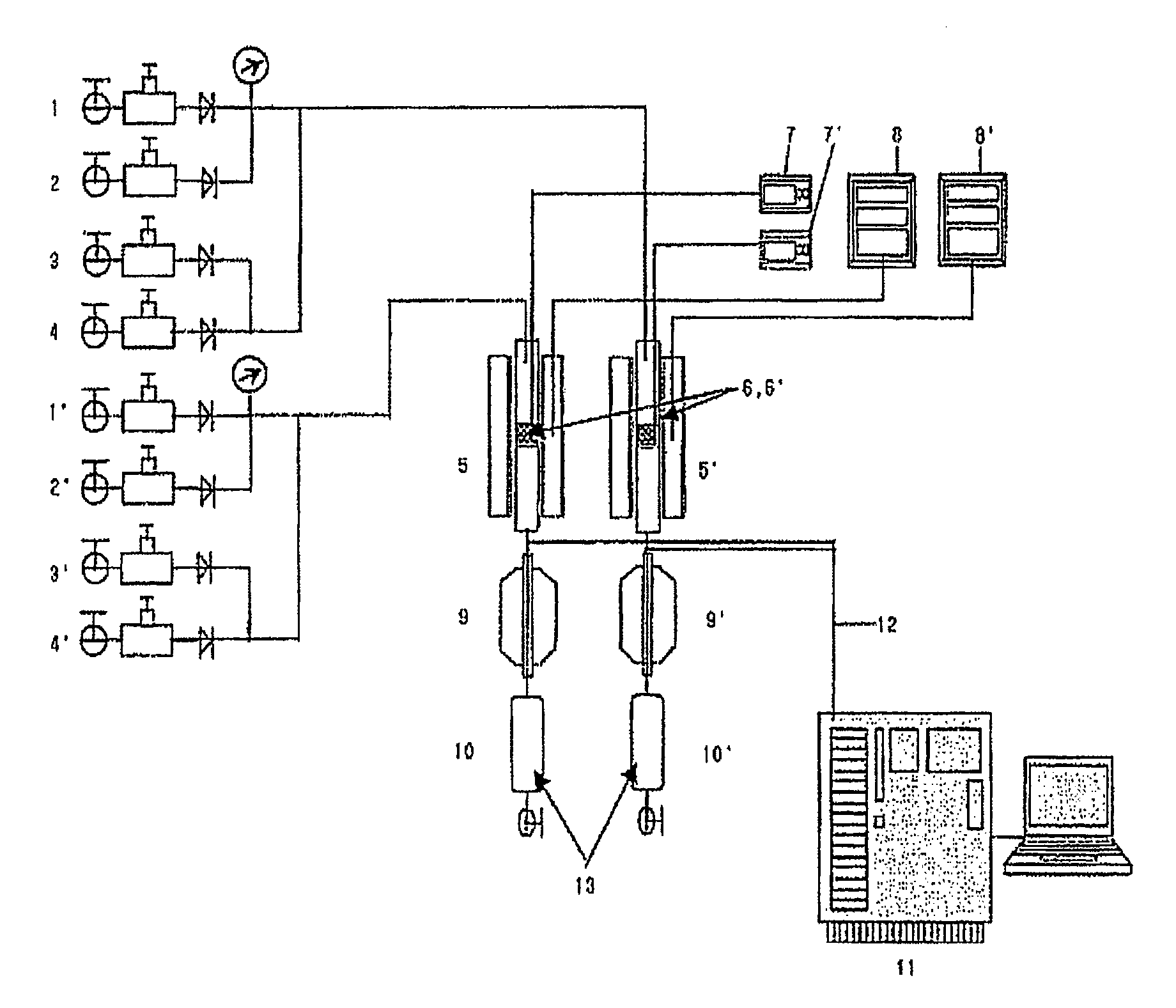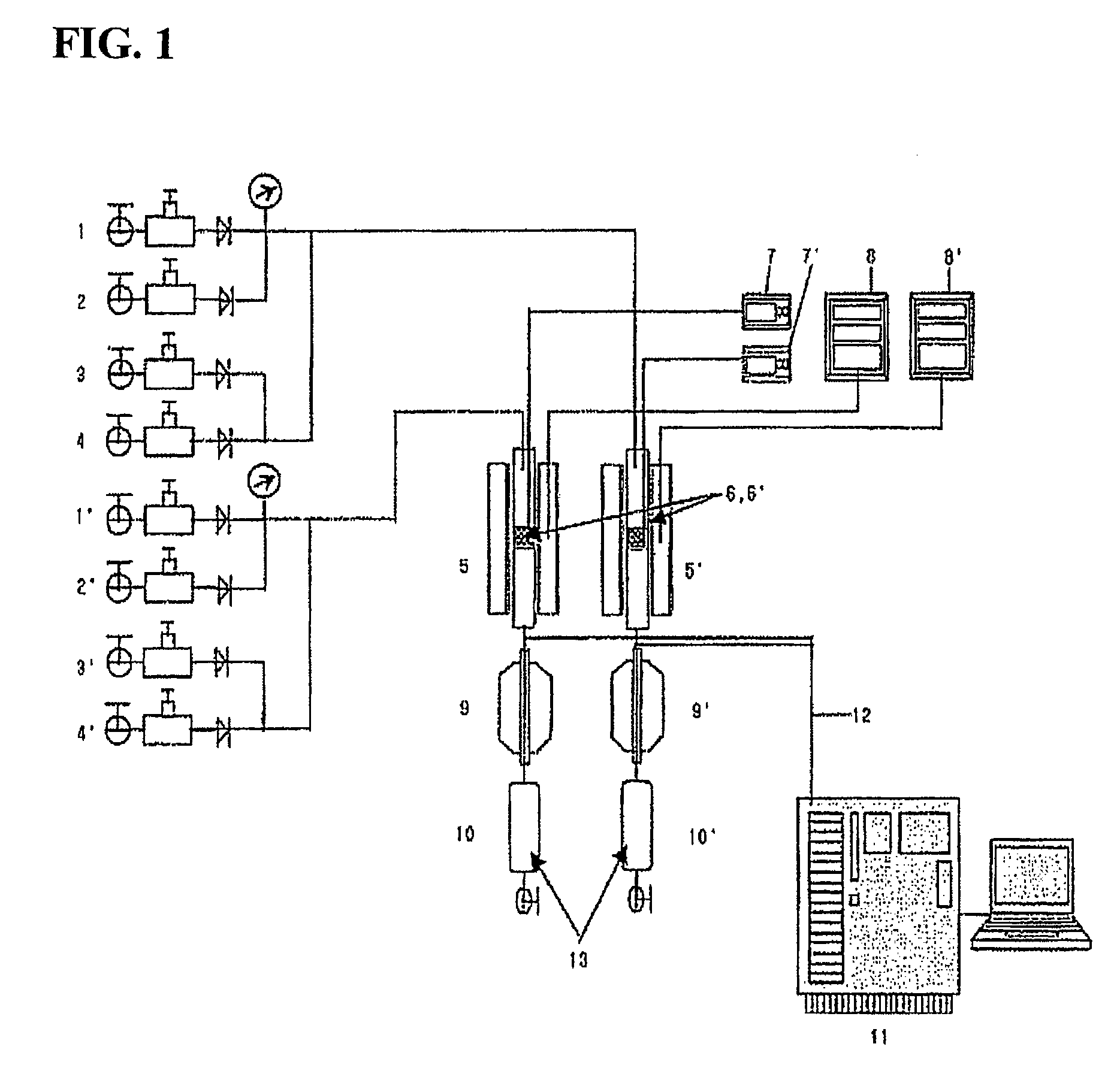Process for production of light olefins from hydrocarbon feedstock
a technology of hydrocarbon feedstock and hydrocarbon oil, which is applied in the direction of hydrocarbon oil treatment products, physical/chemical process catalysts, organic chemistry, etc., can solve the problems of difficult to improve energy efficiency, light naphtha, and difficult to control the composition of olefins, etc., to achieve excellent hydrothermal stability, high yield, and high selectivity
- Summary
- Abstract
- Description
- Claims
- Application Information
AI Technical Summary
Benefits of technology
Problems solved by technology
Method used
Image
Examples
example 1
[0066] A) Preparation of Catalyst
[0067] To 100 mL of distilled water, 10 g of HZSM-5 (Zeolyst) with a Si / Al molar ratio of 25, and 0.55 g of concentrated phosphoric acid (85% H3PO4), were added and stirred for 20 minutes. To the stirred solution, 0.36 g of Mg(OH)2 was added and the mixture was adjusted to a pH of 7-8 using ammonia water, followed by stirring at a temperature of about 45° C. for about 20 minutes. Next, the mixture was stirred at about 50° C. until the water completely evaporated, and then, vacuum filtration was used to separate the solid product. The separated solid product was calcined in air at a temperature of 500° C. for 5 hours, thus preparing an Mg—HPO4—HZSM-5 catalyst.
[0068] B) Steaming Step for Evaluation of Hydrothermal Stability
[0069] To evaluate the hydrothermal stability of the catalyst, the catalyst was maintained in an atmosphere of 100% steam at 750° C. for 24 hours.
[0070] C) Production of Light Olefins
[0071] As shown in FIG. 1, a system for measu...
example 2
[0074] A) Preparation of Catalyst
[0075] To 100 mL of distilled water, 10 g of HZSM-5 (Zeolyst) with a Si / Al molar ratio of 25, and 0.26 g of concentrated phosphoric acid (85% H3PO4), were added and stirred for about 20 minutes. To the stirred solution, 0.08 g of Mg(OH)2 was added, and the mixture was adjusted to a pH of 2-3 using an aqueous nitric acid solution, followed by stirring at about 45° C. for about 20 minutes. After stirring the mixture at about 50° C. until water completely evaporated, vacuum filtration was performed to separate the solid product. The separated solid product was calcined in air at a temperature of 500° C. for 5 hours, thus preparing a Mg—H2PO4—HZSM-5 catalyst.
[0076] B) Steaming Step for Evaluation of Hydrothermal Stability
[0077] Steaming was carried out in the same manner as in Example 1.
[0078] C) Production of Light Olefins
[0079] The production of light olefins was carried out in the same manner as in Example 1.
[0080] The obtained results for conve...
example 3
[0081] A) Preparation of Catalyst
[0082] Slurry comprising 6.6 kg of the Mg—H2PO4—HZSM-5 prepared in the part (A) of Example 2, 0.7 kg of Y zeolite and 3 kg of an alumina binder was stirred, followed by spray drying, thus preparing a pelletized catalyst with an average particle size of 80 μm.
[0083] B) Steaming for Evaluation of Hydrothermal Stability
[0084] Steaming was carried out in the same manner as in Example 1.
[0085] C) Production of Light Olefins
[0086] In this Example, a fluidized-bed reaction system was used to measure the activity of the catalyst during the production of light olefins. The fluidized-bed reaction system comprises a riser reactor, a regenerator, a striper and a stabilizer. The riser reactor is 2.5 m in height and 1 cm in diameter, the regenerator is 1.5 m in height and 12 cm in diameter, the stripper is 2 m in height and 10 cm in diameter, and the stabilizer is 1.7 m in height and 15 cm in diameter.
[0087] As feedstock, naphtha specified in Table 1 above w...
PUM
| Property | Measurement | Unit |
|---|---|---|
| temperature | aaaaa | aaaaa |
| weight ratio | aaaaa | aaaaa |
| temperature | aaaaa | aaaaa |
Abstract
Description
Claims
Application Information
 Login to View More
Login to View More - R&D
- Intellectual Property
- Life Sciences
- Materials
- Tech Scout
- Unparalleled Data Quality
- Higher Quality Content
- 60% Fewer Hallucinations
Browse by: Latest US Patents, China's latest patents, Technical Efficacy Thesaurus, Application Domain, Technology Topic, Popular Technical Reports.
© 2025 PatSnap. All rights reserved.Legal|Privacy policy|Modern Slavery Act Transparency Statement|Sitemap|About US| Contact US: help@patsnap.com



